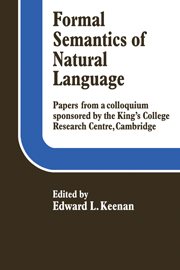Book contents
- Frontmatter
- Contents
- Notes on the contributors
- Acknowledgements
- Introduction
- I QUANTIFICATION IN NATURAL LANGUAGE
- II REFERENCE AND CROSS REFERENCE
- III INTENSIONAL LOGIC AND SYNTACTIC THEORY
- Two theories about adjectives
- Partial interpretations
- Subcategorization of adnominal and adverbial modifiers
- Should generative semantics be related to intensional logic?
- Transformational semantics
- IV QUESTIONING MODEL THEORETIC SEMANTICS
- V PRAGMATICS AND SENTENCES IN CONTEXT
- VI SEMANTICS AND SURFACE SYNTAX
Transformational semantics
Published online by Cambridge University Press: 05 November 2011
- Frontmatter
- Contents
- Notes on the contributors
- Acknowledgements
- Introduction
- I QUANTIFICATION IN NATURAL LANGUAGE
- II REFERENCE AND CROSS REFERENCE
- III INTENSIONAL LOGIC AND SYNTACTIC THEORY
- Two theories about adjectives
- Partial interpretations
- Subcategorization of adnominal and adverbial modifiers
- Should generative semantics be related to intensional logic?
- Transformational semantics
- IV QUESTIONING MODEL THEORETIC SEMANTICS
- V PRAGMATICS AND SENTENCES IN CONTEXT
- VI SEMANTICS AND SURFACE SYNTAX
Summary
Purpose
In this paper I want to present the general framework of a semantic theory which can describe partial meaning relations between sentences of natural languages; relations such as partial synonymy, partial consequence, partial incompatibility. I will call such a theory henceforth semantics and sometimes also grammar. Three features are important for the kind of semantics proposed here: first, the theory only makes use of transformational rules (henceforth: T-rules) which are stated within a formalism that is a modified and generalized version of the formulation of Ginsburg and Partee (1968) and Brockhaus (1972). Second, logical systems developed within the framework of predicate logic can be embedded into this theory without difficulties. The system can be connected with a model theory. And third, the theory lends itself to later justification from speech act theory.
I mention these points explicitly because I think that a semantics of natural language should be conceived in such a way as to make use of the results of three important contemporary linguistic schools: transformational grammar as worked out by Harris, Chomsky and others; formal logic in the widest sense including model theory, and speech act theory (Austin, Searle and others).
Nevertheless, a semantic theory cannot simply be a chaotic mixture of these or other different approaches, but the goals of such a theory should be determined independently in a clear way.
In this paper I discuss the goals of a semantic theory, and then propose a criterion of adequacy.
Information
- Type
- Chapter
- Information
- Formal Semantics of Natural Language , pp. 205 - 216Publisher: Cambridge University PressPrint publication year: 1975
